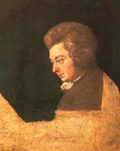Trivia
Bassoon classics - Chamber music works
Chamber music for solo bassoonists came to be composed in earnest in the first half of the 18th century (late Baroque period). However, as compositions from that period are not frequently performed today, we present some works that date since the classical period.
W. A. Mozart: Sonata for Bassoon and Cello in B♭ Major KV.292
This work is known as the "Sonata for Bassoon and Cello", but as the cello part could be considered a "basso continuo" bass accompaniment, it could be suggested that the part played by the bassoon alongside this basso continuo is in fact a bassoon sonata. The delightful melody, in Mozart's distinctive style, occupies a high register, and it is a work in which one can fully enjoy the charms of the bassoon, referred to in the classical period as the "instrument of love." It is said that Mozart composed the piece for his friend Baron von Dürnitz, who loved the bassoon.

Wolfgang・Amadeus・Mozart
C. Saint-Saëns: Sonata for Bassoon and Piano Op. 168
In 1921, the year he died at age 86, Saint-Saëns worked on a number of sonatas for the oboe, clarinet and bassoon together with the piano. His "Sonata for Bassoon and Piano" is written in G Major, and has quite a conservative feel for its time. However, its unconventional melody and refined harmony express an unfolding dialogue between the piano and bassoon, and its style is representative of the pioneering maturity showed in his last works.
Musical Instrument Guide : Bassoon Contents
Structure
- What Kind of Musical Instrument is a Bassoon?
- A Long Tube that can be Separated
- The Bocal and its Various Functions
- Unique Features of the bassoon, and How to Play
- [Experiment1]Comparing the Sound of Tone Holes cut Obliquely and Perpendicular
- [Experiment2]Encasing the Bore in Various Materials
- Bonus Experiment
How to Play
How the Instrument is Made
Choosing an Instrument
Trivia
- An Instrument that is Sensitive to Humidity
- Sounds from water in the U-tube?
- There's a needle in the bocal?!
- Comments by conductors caused popularity to tumble?
- Bassoon classics - Chamber music works
- Bassoon classics - Concertos
- Is the "contra-fagotto" a contrabassoon?
- What is the best tool to file a reed?
